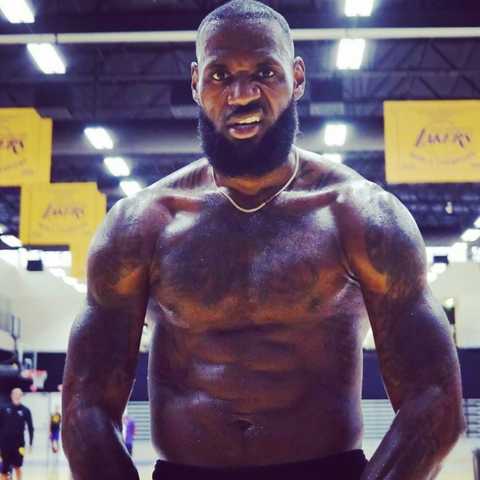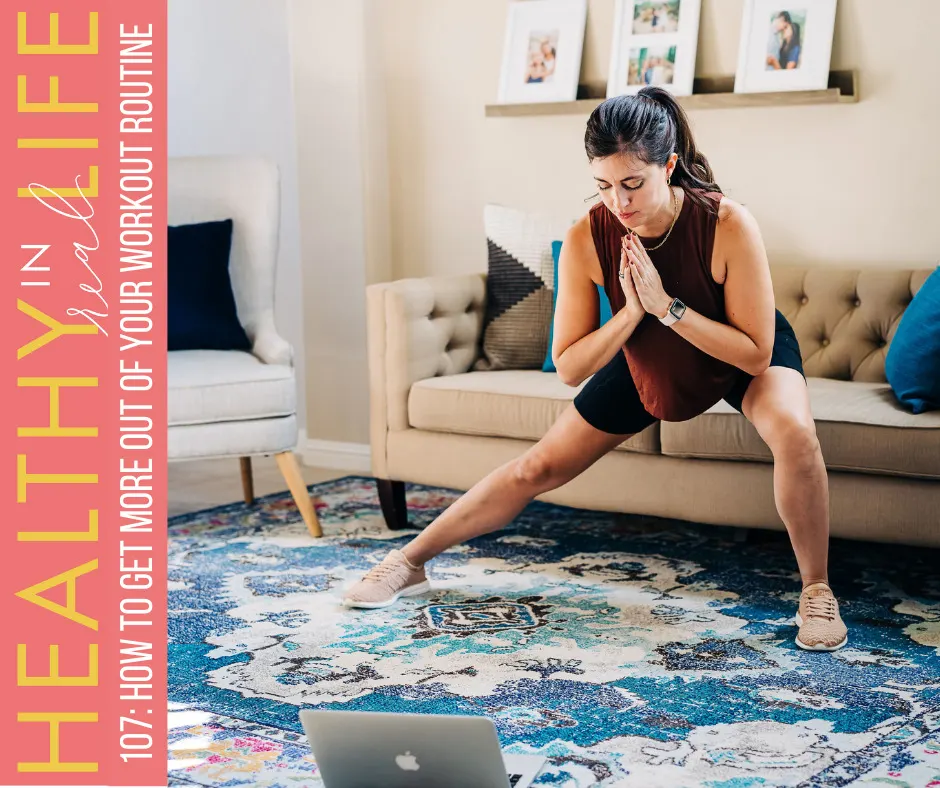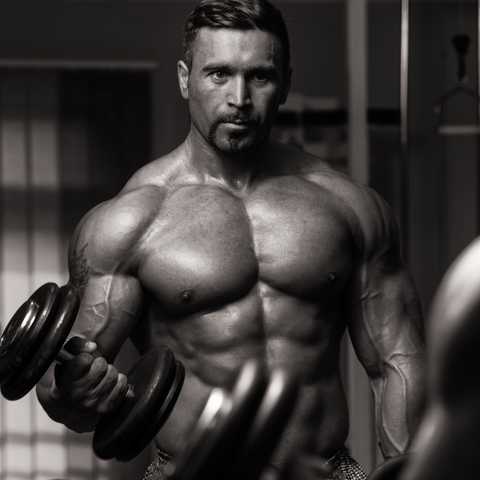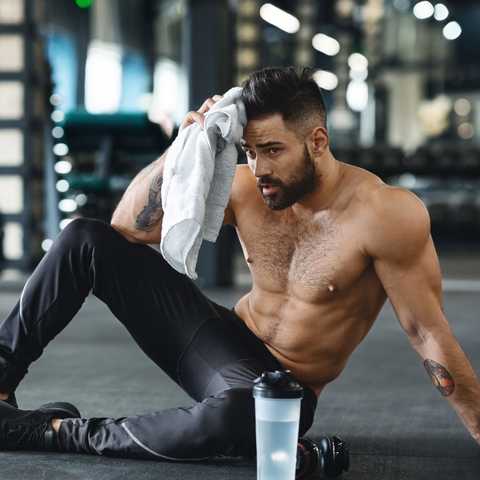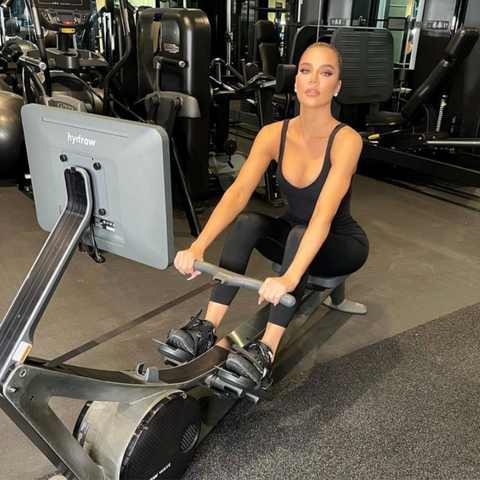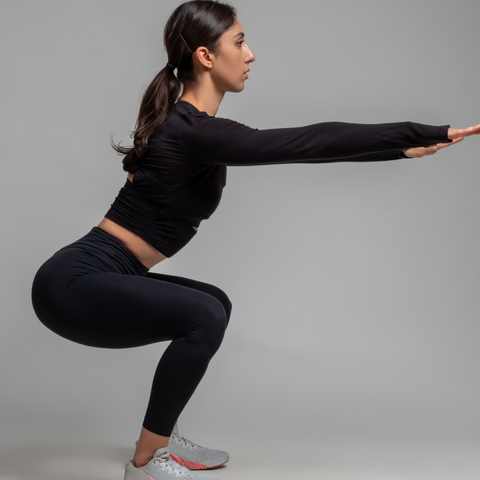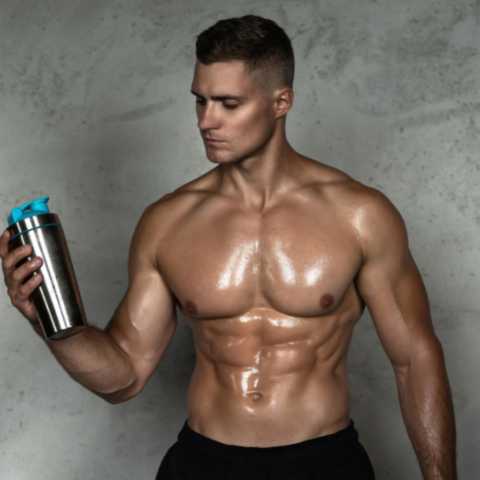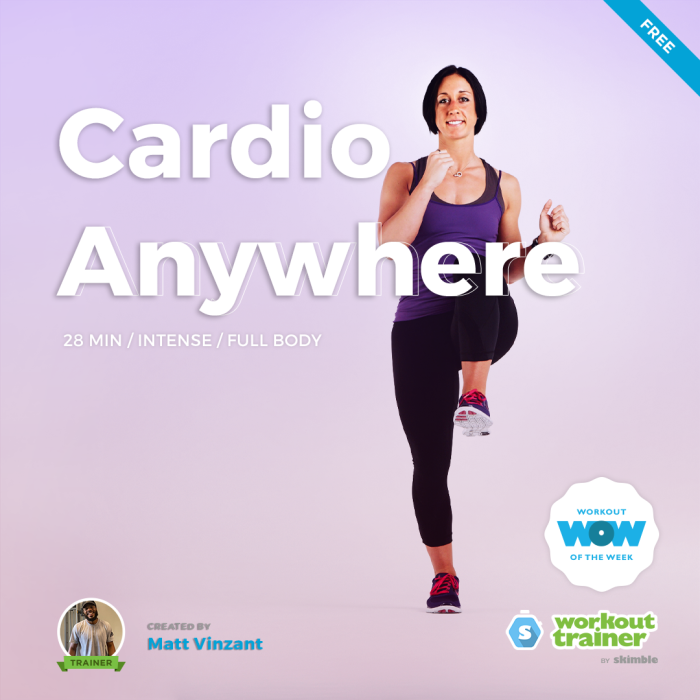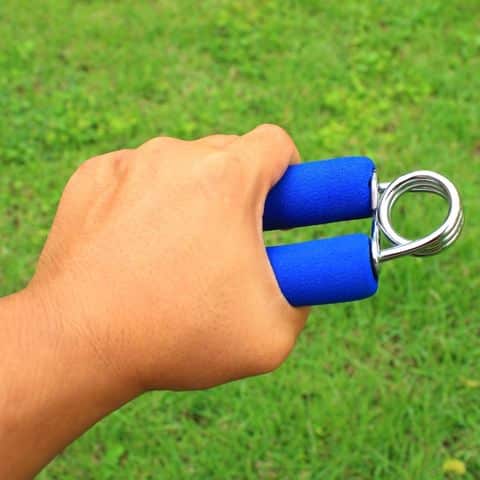We love bodyweight training and have put together this bodyweight workout plan for building muscle. What you have here is a specialized workout plan that utilizes progressive overload to ensure that you build strength and muscle mass as you progress through the weeks.
Table of Contents:
- The split you’ll be using for this 8-week bodyweight workout plan
- Your 8-week bodyweight workout routine
- Important lessons on bodyweight training
- How to run this bodyweight workout plan effectively for muscle growth
- How to perform the bodyweight exercises in this 8-week program
- Benefits of bodyweight training
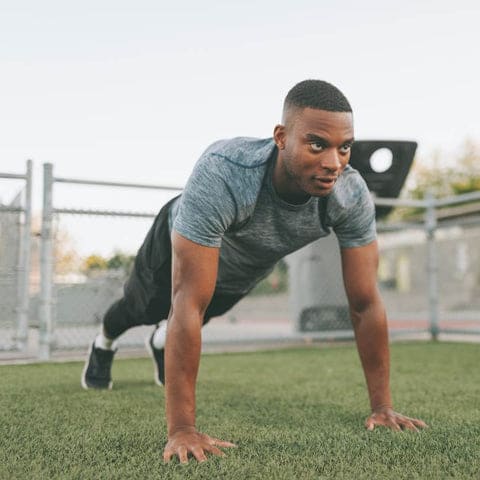
The Best 8-Week Bodyweight Workout Plan
This 8-week bodyweight workout plan focuses on smart programming, progressive overload, and functional movement patterns. It is designed to help you build strength and muscle mass, with emphasis on the latter, using nothing but your own bodyweight.
But before we jump right into the routine, let’s quickly discuss the split you’ll be using (and why)…
Your Bodyweight Workout Split: 4-Day Upper Body & Lower Body
We find that the best training split for bodyweight training is a 4-day split in which you train the upper body two days a week and the lower body two days a week.
With bodyweight training, you really can’t do too much isolation work, so the upper lower split works well as it naturally emphasizes compound movements.
What’s more, you will be more limited in your exercise selection with bodyweight training, which is why a bodypart “bro-split” doesn’t really make sense.
Of course, there are other splits that work well with bodyweight training, such as the push pull legs split or a full body routine. However, these two routines have some downfalls that make the upper lower more appealing for bodyweight workouts.
The push pull leg split still requires a fair bit of isolation work and exercise selection like the bodypart split, and the scheduling can get confusing if you opt to do more than 3 days a week, which most people who train bodyweight-only want and likely need. As for a full body routine, while effective for staying in shape, it won’t do as well for building muscle as over time it’ll be harder and harder to produce enough volume for each muscle group to grow.
Finally, as a seasoned trainee myself (and personal trainer/strength coach), I feel that 4 days of training and 3 days of rest per week is the sweet spot for building muscle and optimizing recovery (yes, this applies to bodyweight training too). Needless to say, an upper lower split works perfectly for training 4 days a week.
For reference, the easiest and arguably best way to schedule your 4 workouts per week is as follows:
- Day 1: Upper Body Session 1
- Day 2: Lower Body Session 1
- Day 3: Rest
- Day 4: Upper Body Session 2
- Day 5: Lower Body Session 2
- Day 6-7: Rest
Note: You can play around with the rest days as you see fit, just make sure you hit your 4 sessions weekly.
Now, let’s get into the 8-week bodyweight workout routine…
Week 1-4:
| Session 1 | Session 2 | Session 3 | Session 4 |
| Pull Up: 5×5-10 | Split Squat: 5×15-20 | Chin Up: 5×4-6 | Split Squat: 5-10 |
| Dip: 5×5-10 | Lateral Jump Lunges: 5×10-20 | Decline Push Up: 5×5-10 | Reverse Lunge: 50 reps in total |
| Push Up: 5×5-10 | Glute Bridge March: 50 reps total | Inverted Row (change grip): 5×5-10 | Air Squat: 5xAMAP |
| Inverted Row (alter grip as needed): 5xAMAP | Lunges: 50 reps total | Dip: 5×15-20 | Glute Bridge: 5xAMAP |
| Incline Push Up: 5xAMAP | Air Squat: 5xAMAP | Push Up: 5×15-20 | Calf Raise: 5xAMAP |
| Calf Raise: 5xAMAP | Leg Raises: 3×5-10 |
Note: AMAP = As many (reps) as possible
Week 5-8:
| Session 1 | Session 2 | Session 3 | Session 4 |
| Dip: 5×5-10+ | Jumping Lunge: 5×10-20 | Close Grip Chin Up: 5xAMAP | Jumping Lunge: 10-20 |
| Pull Ups: 5×5-10 | Jump Squat: 5×10-20 | Ballistic Push Up: 5×10-20 | Glute Bridge: 5xAMAP |
| Decline Push Up: 5×5-10 | Bulgarian Split Squat: 5xAMAP | Inverted Row (change grip): 5×15-20 | Jump Squat: 5×10 (AMAP on the last set) |
| Chin Up: 5×5-10+ | Stationary Reverse Lunge (same leg): 5xAMAP | Dip: 5xAMAP | Calf Raise: 5xAMAP |
| Incline Push Up: 5xAMAP | Glute Bridge: 5xAMAP | Close Grip Push Up: 5xAMAP | Squat: 5xAMAP |
| Inverted Row: 5xAMAP | Push Up: 5xAMAP | Leg Raises: 3×8-12 |
The Most Important Lesson About Bodyweight Training:
One of the greatest misunderstandings about bodyweight training is that it’s somehow completely different than resistance training with weights.
Some people will tell you to do 300 push-ups a day or train every day.
That’s ridiculous.
The only way you can train like that is if you’re so fit that 300 push-ups are “lightweight”, or in other words, not very challenging…
It would be like bench pressing 30% of your 1RM 300 times, every day. That’s not really going to do much in the long run, now is it?
To be clear, we’re not saying that would be easy, nor are we saying it’s literally doing nothing. It’s still great for muscle endurance and will keep you in shape, but it’s not challenging enough to increase strength or illicit muscle growth.
Bodyweight training needs to be thought of in a similar way as weight training. If you want to build muscle, you need a challenging routine that involves progression, and you need adequate rest to let your muscles recover from the continually strenuous workouts.
On that note, let’s discuss how to progress over the course of this program…
HOW TO BUILD MUSCLE WITH THIS 8-WEEK BODYWEIGHT WORKOUT PROGRAM?
With weight training programs, you’ll often have specific exercises with a narrow rep range to follow (i.e. 10-12 reps), and progressive overload is achieved by simply increasing the weight load so you remain challenged within that rep range each week.
While the general concept of progressive overload is the same for bodyweight training (continue to challenge yourself by increasing the difficulty), the approach has to be different since you can’t just incrementally slap on more weight over time.
You might be thinking, just add reps to progress, right?
Although more reps is definitely a way to induce progressive overload, it is too limiting and time consuming to be the only method of progression. Because of that, we need to consider other forms of progressive overload for bodyweight workouts, which we will now go over in detail…
Progressive Overload for Bodyweight Training
The methods you’ll use for progressive overload are as follows:
- Increase reps
- Do more challenging variations
- Alter tempo and intensity
- Decrease rest time
But let us explain how each should be employed…
As you probably noticed, the workout plan includes several basic “exercise groups”. For example, “push ups”, which of course have a standard variation, but also many other variations that can make the exercise harder or easier (as well as target muscle groups differently) – i.e., wide grip, close grip, diamond, side to side, etc.
You’ll also notice the exercises have either a (fairly wide) rep range or “AMAP” (as many reps as possible).
For any exercise that has set rep range, follow this process of progressive overload:
- If it is a general exercise (e.g. push up, pull up, dip) do a variation that challenges you in the given rep range (i.e. beginners may need to do pull ups with a closer grip to hit the prescribed rep range).
- When you reach the high end of the rep range (it might take a week, two weeks or several weeks), implement a harder variation. Note: If you can’t implement a harder variation or we set a specific exercise in the plan (i.e. decline push ups), play around with the tempo, intensity and rest time between sets to increase difficulty.
The point is for you to not increase the reps past the high end of the given rep range, but rather choose a harder exercise from the same exercise family or increase the difficulty through intensity and/or tempo so the rep range we provided is challenging.
Now, for exercises with “AMAP”, the main focus of progression is increasing reps…at least at first. The purpose of using AMAP is so you take the exercise to failure (or at least near failure), which is great for hypertrophy (building muscle). Its also great for increasing your muscular endurance.
Be that as it may, you’ll have to use some common sense for when it’s time to alter the exercise, as you don’t want to end up spending 20+ minutes on an exercise because you can do tons of reps.
If you find an AMAP set takes you 1-2+ minutes to reach failure, then you need to play with the tempo or intensity to increase the difficulty OR do a harder variation (glute bridges -> single leg glute bridge or elevated glute bridge or single leg elevated glute bridge). So, it’s good to increase reps, but don’t feel limited to just that with AMAP sets.
Increasing intensity is often overlooked in beginner bodyweight workout plans, so we want to highlight this quickly with an example: Let’s say jump squats are becoming easier and easier, rather than doing endless reps or trying to come up with a new variation, you can increase the difficulty by using a larger range of motion (squatting deeper) and jumping higher with more explosiveness. People often just go through the motions when exercising, so be mindful of your intensity; it can make a huge difference!
Lastly, you can also use implements like a weighted vest or dip belt if you have them and are advanced enough. This will allow you to progressive overload an exercise with weight just like weight training. But for the purpose of this being a “bodyweight-only” plan, we won’t go into more detail. It’s pretty straightforward anyway.
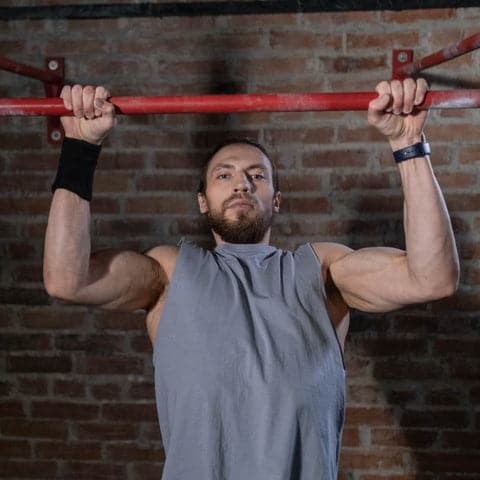
The Bodyweight Exercises You’ll Be Doing:
To help you better understand exercise selection, we will now go through the different families of exercises that you will be using throughout your bodyweight workout plan, which includes potential variations for you to choose from.
Note that you are not limited to the exercise variations below, but we do recommend that you stick to the the program in terms of the exercise family, sets and reps.
Note: We will provide links to other resources on our site where possible so you can look at more exercise variations.
1. Push-Ups (Chest, Triceps, Shoulders)
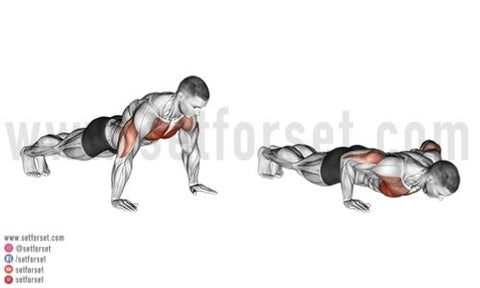
Push-ups will be your primary horizontal pressing movement, similar to the bench press being your primary barbell horizontal pressing movement. In fact, studies show that when loaded equivalently, the bench press and push-up have very similar muscle activation. This includes muscle firing sequence as well as similar EMG readings. Therefore these will likely always be a part of your bodyweight workout plan. Either as your primary exercise of a burnout set.
To perform a traditional push-up, get into a high plank with harms extended at shoulder width apart. Brace your core muscles to keep your hips from sagging. Let your body drop and have your elbows back, so they’re at a 45-degree angle with your body. Come down slowly until your chest touches the ground, and then power up with explosive power.
Incline Push-ups: Incline push-ups are going to be the equivalent of the decline bench press. Because you’re lifting with the body on an incline, these will always be the easiest to perform as you lift a smaller percentage of body weight. As far as what muscle groups are hit, these will work the triceps more, as well as the lower chest. To perform these, you need an object 2-3 feet high. Don’t worry if it’s not exact, as using different heights is never a bad thing. When you set up, you will want to place your hands slightly lower than chest level as your body will swing some.
Decline Push-ups: Decline push-ups will be the equivalent of your incline bench press. In contrast to the incline push-up, these will be your hardest variation as you lift more of your body weight. For muscle groups, it will hit more muscle fibers in your shoulders, similar to the incline press. Use an object that’s about 2-3 feet high, but again, variety is great. Again, place your hands farther back because your body will sway back as you come down. Depending on how high you place your feet, your hands should be around your lower chest.
Other Progressions And Variations On Push-ups:
- Wide-Grip Push-up: The wide-grip push-up can be a stand-alone exercise or part of a progression. As your hands are wider, you have less bend in your elbows, making it more akin to a chest fly. In other words, it will activate more muscle fibres in your pecs. Your grip can vary, but at the minimum, each hand should be placed one hand width apart.
- Narrow Grip Push-Up The narrow grip push-up is similar to the wide grip as it can be both a stand-alone or progression. These are performed by placing your hands closer together, which causes more elbow flexion. As a result, you’ll get more activation in the triceps.
- Side-to-Side Push-Ups: The first progression is going to be side-to-side push-ups. To perform these, instead of coming down straight, you bring your chest down to one hand. This will place a greater percentage of your body weight on that side and effectively increase the load. You can alternate these or go down to one side at a time.
- One Arm Raised: Place one hand on a block. This causes more flexion in that elbow and a greater load. You can combine this coming down to the hand as well.
- One Arm Stretched Out: These are awesome for strength training if you’re not ready for one-arm push-ups. Stretch one hand all the way you the side so that it’s able to offer minimal help. Then as you come down, come down to the pressing hand.
- Pike Push Ups: If you want to give your delts so more love, the pike push up is arguably the best bodyweight exercise you can do. It involves bringing your feet up onto a platform, with your hands on the ground, so that your body almost makes a 90 degree angle and you are pressing up from the ground in a way that mimics an overhead press.
If that’s not enough, here are 33 push up variations from beginner to advanced.
2. Dips (Triceps, Chest, Shoulders)
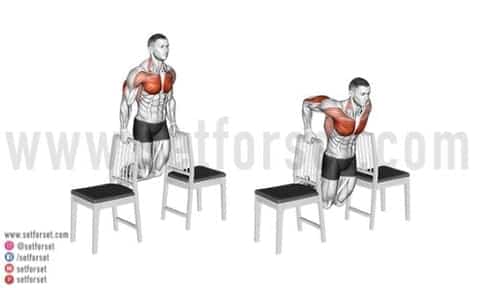
Dips are another upper-body pushing exercise that trains your chest, triceps, and shoulders. While not as popular as push-ups, parallel dips are a significantly harder exercise, making them an essential exercise for maximizing muscle growth.
To do traditional dips, use two parallel bars and place the meat of your hand on each bar, so your forearm is straight up and down. Extend your arms and lift your entire body. Let your elbows drop back but keep your forearms vertical. Lean forward slightly and come down until your triceps are parallel with the ground.
This can also be done with two chairs, as shown in the pic above. Place two chairs next to each other so you can sit between them. Place the meat of your palms on edge and extend your legs out in front so that your hips align with your hands. Let your body drop straight down, keeping your forearms straight. Go down until your triceps are parallel to the ground.
Other variations of dips include:
- Standing Dip: These are a dip that allows you to stand so you can take the weight off your body. Basically, a form of assisted dip and is a great beginner bodyweight exercise.
- Side-To-Side: Use the same concept of bringing your weight down to one side.
There are many more dip variations to consider too. Here are 15 dip variations with explanations of how to do each.
3. Chin-Ups (Back, Biceps, Forearms)
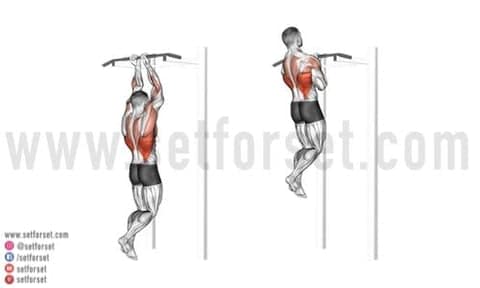
Chin-ups are going to be a stand-alone exercise apart from pull-ups. This is simply because you have a limited amount of exercises with bodyweight training, and so the chin-ups are different enough to provide a unique stimulus.
To perform a chin-up, grab a pull-up bar with a shoulder-width grip. Pull your shoulder blades back and pull your elbows down until your chin raises above the bar.
You also have a close grip chin up in the program, which is just bringing your hands closer together (slightly easier variation).
4. Pull-Ups (Back, Biceps, Forearms)
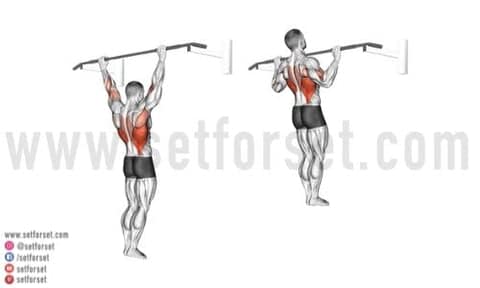
Pull-ups are another of your foundational exercise for vertical pulling. The primary difference is that they use an overhand grip. However, this isn’t actually what creates the difference in biomechanics.
When you use an overhand grip, your elbows will go out to your side, and so when you pull down, you perform shoulder adduction rather than shoulder extension. In addition, you use fewer biceps, especially with wide-grip pull-ups.
A couple advanced pull up variations are:
- To One Side: Pull your body weight up to one hand.
- Archer Pull-Up: Start the movement similar to a one-sided pull-up. However, as you come up, completely stretch out your non-pulling hand and keep your wrist on top of the pull up bar. This severely mitigates its use.
If you can’t do pull ups or you want more advanced options, check out our pull up progression guide.
By the way, if you don’t have a pull up bar, you need to get one. Here’s our top choices for pull up bars.
5. Inverted Rows (Back, Biceps, Forearms)
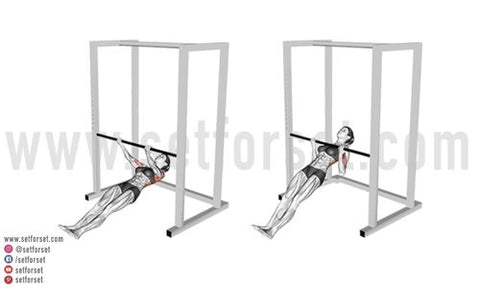
Inverted rows are also called Australian rows as they’re performed by hanging upside down while hanging onto a barbell; think of a push-up position but upside down. These allow you to do a horizontal pulling movement and take the place of the bent-over row and will be your foundational horizontal pulling movement.
You can use both an underhand and overhand grip for these, as well as wide and close grip. The progressions will also be very similar to pull-ups and chin-ups and use the same concepts.
6. Squat (Quads, Hamstrings, Glutes)
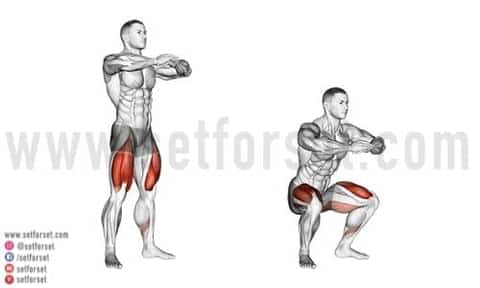
Body squats are your major lower body exercise. However, even for untrained individuals, these can get pretty easy quickly. Therefore, we will sometimes use these with ultra-high reps (30+), or we might do them later in the session, so your legs are fatigued.
While body squats may have more leniency with leaning forward, they are performed exactly like a barbell squat. Place your feet shoulder-width apart or slightly wider in the standing position. Push your hips back to invoke hip flexion and sink while keeping your shoulders over your feet.
Try to keep your back straight and look straight ahead. Continue until your legs are parallel with the ground, and then propel your body up.
7. Lunges (Quads, Hamstrings, Glutes)
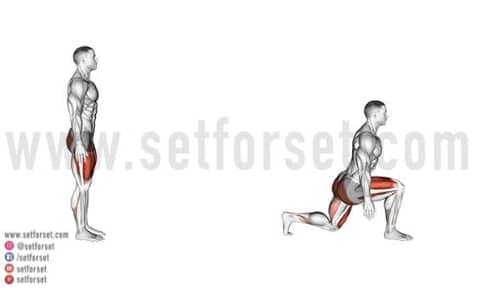
Lunges are great for bodyweight training as they are significantly harder than squats as is. As they are a unilateral exercise (not true unilateral, but we still classify it as such), they will challenge one leg as well as your stabilizer muscle fibres.
One “setback” is that there aren’t a ton of tougher progressions. So similar to bodyweight squats, we like to program these with high repetitions. For example, in one week, you may make 50 lunges which you will do in as many sets as it takes. Then, next week, you may do 55.
To perform the lunge, stand in a natural stance with your feet shoulder-width apart. Take one giant step forward, about twice as far as a natural step. You can start with either your right or left foot, but remember that you will alternate for every step.
With both feet flat on the ground and toes pointing forward, let your drop your body straight down until your rear knee touches the ground. At this point, both knees should be bent at 90 degrees, with the rear knee under your hips and the front knee directly over your foot. If you need, adjust for your next step.
Push off and pull your rear foot so that you return to your starting position. Now repeat and alternate with the other leg.
The program also includes:
- Reverse Lunge: A reverse lunge is the same movement but done in reverse. Instead of stepping forward, you step backward and push off backward.
- Stationary Lunge: A stationary lunge is made by taking a step forward. However, you push back instead of pulling your rear foot to the standing position. There’s really not a significant difference other physiologically other than a new exercise.
Here are some more lunge exercises to consider.
8. Split Squat (Quads, Hamstrings, Glutes)
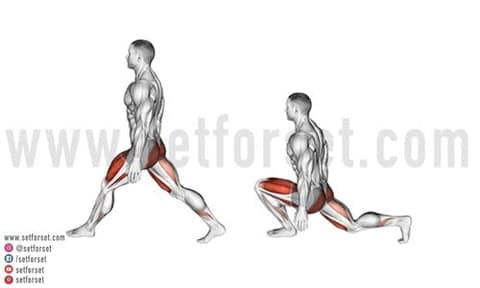
A split squat is basically a lunge, except you never bring your feet back together. This forces you to do one side at a time, meaning they’re actually going to be harder to do high reps with. However, because you’re stationary, you are able to do various progressions.
- Front Foot Raised: The front raised version will have you place your forward foot on a raised object that’s a few inches high. Apart from that, everything else is the same. This allows more flexion in the knee, giving a better quad workout.
- Bulgarian Squat: The Bulgarian squat is one of the most challenging exercises you can do, as it’s a quasi-one-legged squat. To perform this, you need to place your rear foot on a basic bench with the top of your foot on the surface. Your front foot will need to be about as far as a lunge, but you may need to adjust until you get used to the movement. Keep your torso straight and drop straight down. You can keep your arms straight down or on your hips. At the bottom, your forward shin should be vertical, with your knee directly over your foot. Push back-up while concentrating on the quads in your front leg.
9. Glute Bridge (Quads, Hamstrings, Glutes)
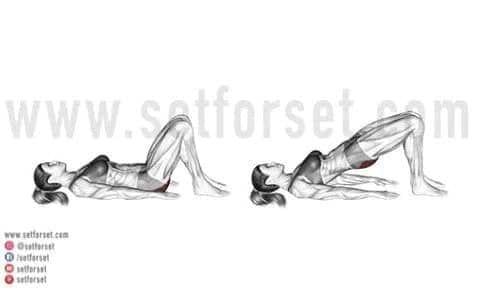
Your posterior chain is difficult to train with the glute bridge being really the only exercise to effectively train it. Being so, you will train these twice a week towards the en of the workout.
Lay on the ground with knees bent so your shins are vertical and feet flat. Brace your core and press your feet down into the ground to thrust your hips forward and extend your hips.
Continue until you hit full hip extension. Really concentrate on squeezing your glutes to maximize activation. Further, you can pull your feet towards you as if you’re trying to pull the ground. This will mimic a leg curl.
Here are a couple ways to progress the basic glute bridge:
- One-Legged Glute Bridge: To increase the load, your primary tool is to use one leg. Choose a leg to train and lift the other leg to extend it. Now perform the same movement with one leg. You can alternate legs to make it easier or perform all reps on one leg for a more intense workout.
- Glute Bridge March: A glute bridge march is a version of the glute bridge that uses an isometric contraction at the top of the movement. Extend your hips so your torso is straight. Now, stay extended and then march your legs up and down while staying extended.
There are actually several other glute bridge exercises to consider as well.
10. Calf Raises

Calf raises are pretty straight forward. However, there are plenty of options here as well. The basic bodyweight calf raise involves stepping the balls of your feet on the edge of a platform or stairs, and moving up and down through a full range of motion.
Good variations include donkey calf raises, single leg calf raises, and jumping calf raises.
11. Plyometrics And Ballistic Exercises

Plyometrics and ballistic style exercise has you use explosive power to propel yourself in the air. The simplest example would be jumping, but we can add an explosive element to any exercise. For example:
- Jump Squat
- Jumping Lunges
- Lateral Jump Lunges
- Ballistic Push-Up
12. Core Exercises
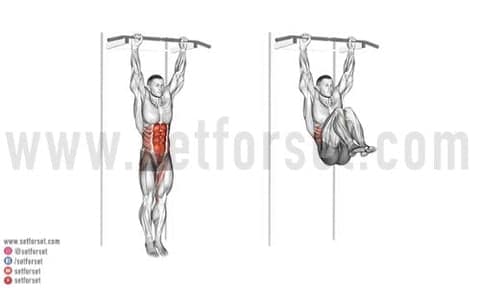
We didn’t touch on core exercises, and the program only includes one core exercise – leg raises. However, you are free to add more core training to your plan as you see fit. A lot of the bodyweight compound movements you do will work your core (i.e. push ups are like an advanced plank), so keep that in mind.
Here are some of the best core exercises (with progressions):
- Lying leg raises -> Hanging leg raises
- Crunches -> Decline Crunch
- Plank -> Plank with Knee Drive
- Side Plank -> Side Plank with Hip Dip
- Ab Rollout -> Plank Walkout
Advanced Bodyweight Workout Options:
- Pistol Squat
- Skater Squat
- Muscle Ups
- One-Arm Push-Up
While these aren’t programmed in the 8-week bodyweight workout plan above, as they are more geared towards “advanced calisthenics”, we want you to see what you’re aiming for with your bodyweight training.
Top 3 Benefits Of Bodyweight Training:
Bodyweight workouts have a ton of excellent benefits that can be of interest to anyone. Here are our top reasons to be involved with bodyweight training:
- Bodyweight training encourages fat loss as its movements will be easier.
- Bodyweight exercises build muscle AND can burn fat as they’re all compound exercises.
- Improve your athleticism.
Summary Of Your Bodyweight Workout Plan:
Bodyweight training is a fantastic form of resistance training when it’s applied properly. When we say it’s applied correctly, we mean that it’s treated like every other form of resistance training that we do. This means using proper rep schemes, rest periods, and some basic periodization. Perhaps the most critical aspect is that you use progressive overload by constantly working towards more challenging versions. If you follow these guidelines, you will definitely see growth and strength gains with this bodyweight routine.

